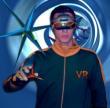Jan 20, 2006
Motor learning: its relevance to stroke recovery and neurorehabilitation
Motor learning: its relevance to stroke recovery and neurorehabilitation
Curr Opin Neurol. 2006 Feb;19(1):84-90
Authors: Krakauer JW
PURPOSE OF REVIEW: Much of neurorehabilitation rests on the assumption that patients can improve with practice. This review will focus on arm movements and address the following questions: (i) What is motor learning? (ii) Do patients with hemiparesis have a learning deficit? (iii) Is recovery after injury a form of motor learning? (iv) Are approaches based on motor learning principles useful for rehabilitation? RECENT FINDINGS: Motor learning can be broken into kinematic and dynamic components. Studies in healthy subjects suggest that retention of motor learning is best accomplished with variable training schedules. Animal models and functional imaging in humans show that the mature brain can undergo plastic changes during both learning and recovery. Quantitative motor control approaches allow differentiation between compensation and true recovery, although both improve with practice. Several promising new rehabilitation approaches are based on theories of motor learning. These include impairment oriented-training (IOT), constraint-induced movement therapy (CIMT), electromyogram (EMG)-triggered neuromuscular stimulation, robotic interactive therapy and virtual reality (VR). SUMMARY: Motor learning mechanisms are operative during spontaneous stroke recovery and interact with rehabilitative training. For optimal results, rehabilitation techniques should be geared towards patients' specific motor deficits and possibly combined, for example, CIMT with VR. Two critical questions that should always be asked of a rehabilitation technique are whether gains persist for a significant period after training and whether they generalize to untrained tasks.
20:55 Posted in Cybertherapy | Permalink | Comments (0) | Tags: Positive Technology, virtual reality, cybertherapy
Dec 15, 2005
Combined use of fMRI and VR to teach pain control
A paper published on Proceedings of National Academy of Science describes results of an experiment, in which virtual reality is used in combination with fMRI to teach subjects to control pain perception. A display inside the fMRImachine depicted a flame whose intensity reflected the activity of participants rostral anterior cingulate cortex (rACC), a brain region that is known to be involved in pain perception. Results showed that the better participants controlled their rACC activity, the better they controlled their pain. By contrast, participants included in a control group without fMRI feedback, failed to control their pain.
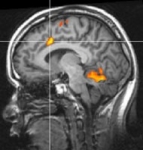
Read the full article in PDF format
01:25 Posted in Cybertherapy | Permalink | Comments (0) | Tags: Positive Technology, virtual reality, cybertherapy
Dec 13, 2005
The Use of Virtual Reality and Audiovisual Eyeglass Systems as Adjunct Analgesic Techniques: A Review of the Literature.
Ann Behav Med. 2005;30(3):268-278
Authors: Wismeijer AA, Vingerhoets AJ
23:30 Posted in Cybertherapy | Permalink | Comments (0) | Tags: Positive Technology, virtual reality, cybertherapy
Dec 12, 2005
Virtually Driving: Are the Driving Environments "Real Enough" for Exposure Therapy with Accident Victims? An Explorative Study
Cyberpsychol Behav. 2005 Dec;8(6):532-537
Authors: Walshe D, Lewis E, O'sullivan K, Kim SI
There is a small but growing body of research supporting the effectiveness of computergenerated environments in exposure therapy for driving phobia. However, research also suggests that difficulties can readily arise whereby patients do not immerse in simulated driving scenes. The simulated driving environments are not "real enough" to undertake exposure therapy. This sets a limitation to the use of virtual reality (VR) exposure therapy as a treatment modality for driving phobia. The aim of this study was to investigate if a clinically acceptable immersion/presence rate of >80% could be achieved for driving phobia subjects in computer generated environments by modifying external factors in the driving environment. Eleven patients referred from the Accident and Emergency Department of a general hospital or from their General Practitioner following a motor vehicle accident, who met DSM-IV criteria for Specific Phobia-driving were exposed to a computer-generated driving environment using computer driving games (London Racer/Midtown Madness). In an attempt to make the driving environments "real enough," external factors were modified by (a) projection of images onto a large screen, (b) viewing the scene through a windscreen, (c) using car seats for both driver and passenger, and (d) increasing vibration sense through use of more powerful subwoofers. Patients undertook a trial session involving driving through computer environments with graded risk of an accident. "Immersion/presence" was operationally defined as a subjective rating by the subject that the environment "feels real," together with an increase in subjective units of distress (SUD) ratings of >3 and/or an increase of heart rate of >15 beats per minute (BPM). Ten of 11 (91%) of the driving phobic subjects met the criteria for immersion/presence in the driving environment enabling progression to VR exposure therapy. These provisional findings suggest that the paradigm adopted in this study might be an effective and relatively inexpensive means of developing driving environments "real enough," to make VR exposure therapy a viable treatment modality for driving phobia following a motor vehicle accident (MVA).
21:50 Posted in Cybertherapy | Permalink | Comments (0) | Tags: Positive Technology, virtual reality, cybertherapy
Dec 06, 2005
Anticipation of Public Speaking in Virtual Reality Reveals a Relationship Between Trait Social Anxiety and Startle Reactivity
Biol Psychiatry. 2005 Nov 30;
Authors: Cornwell BR, Johnson L, Berardi L, Grillon C
Startle reflex modification has become valuable to the study of fear and anxiety, but few studies have explored startle reactivity in socially threatening situations. METHODS: Healthy participants ranging in trait social anxiety entered virtual reality (VR) that simulates standing center-stage in front of an audience to anticipate giving a speech and count backward. We measured startle and autonomic reactivity during anticipation of both tasks inside VR after a single baseline recording outside VR. RESULTS: Trait social anxiety, but not general trait anxiety, was positively correlated with startle before entering VR and most clearly during speech anticipation inside VR. Speech anticipation inside VR also elicited stronger physiologic responses relative to anticipation of counting. CONCLUSIONS: Under social-evaluative threat, startle reactivity showed robust relationships with fear of negative evaluation, a central aspect of social anxiety and clinical social phobia. Context-specific startle modification may be an endophenotype for subtypes of pathological anxiety.
21:30 Posted in Cybertherapy | Permalink | Comments (0) | Tags: Positive Technology, virtual reality, cybertherapy
Dec 01, 2005
Game to teach street crossing safety
From The Birmingham News
When pilots learn to fly and surgeons to cut, virtual reality comes in handy where blunders can be fatal.
Learning to cross the street is no different, so David Schwebel, associate professor of psychology at UAB, is developing a virtual reality game to teach school children how to cross safely. Of 4,641 pedestrians who died nationwide last year, 363 were 14 and younger, according to the National Highway Traffic Safety Administration...
read the full article here
23:10 Posted in Cybertherapy | Permalink | Comments (0) | Tags: serious gaming, cybertherapy
Nov 09, 2005
Virtual reality-induced neuroplastic changes in chronic stroke
Cortical reorganization and associated functional motor recovery after virtual reality in patients with chronic stroke: an experimenter-blind preliminary study
Arch Phys Med Rehabil. 2005 Nov;86(11):2218-23
Authors: Jang SH, You SH, Hallett M, Cho YW, Park CM, Cho SH, Lee HY, Kim TH
10:00 Posted in Cybertherapy | Permalink | Comments (0) | Tags: Positive Technology, virtual reality, cybertherapy
Nov 08, 2005
Promising results from internet-based self-help for depression
A study recently published by Andersson and co-workers in British Journal of Psychiatry has found that psychological treatment for depression, delivered over the internet, is reliable and effective. 
117 people with mild to moderate depression who met a number of inclusion criteria were included in this randomised controlled trial. The majority came from smaller cities, villages and places outside the larger cities (where university clinics are usually based). 36 participants in the treatment group and 49 in the control group completed post-treatment measures. In total the rate of withdrawal from the programme was 27%. The main reason given was that the treatment was too demanding. Thus the rates of withdrawal differed between the treatment group (37%) and the control group (18%).
It was found that the active treatment, which included standard cognitive-behavioural approaches and behavioural changes, resulted in decreased depressive symptoms immediately after treatment and at the six-month follow-up. There were also benefits in terms of anxiety symptoms and quality of life.
Reference
Andersson G, Bergstrom J, Hollandare F, Carlbring P, Kaldo V and Ekselius L (2005) Internet based self-help for depression: randomised controlled trial, British Journal of Psychiatry, 187, 456-461.
17:15 Posted in Cybertherapy | Permalink | Comments (0) | Tags: Positive Technology, virtual reality, cybertherapy
Nov 03, 2005
Benefits of activity and virtual reality based balance exercise programmes for adults with traumatic brain injury: Perceptions of participants and their caregivers
Brain Inj. 2005 Nov;19(12):989-1000
Authors: Thornton M, Marshall S, McComas J, Finestone H, McCormick A, Sveistrup H
21:45 Posted in Cybertherapy | Permalink | Comments (0) | Tags: Positive Technology, virtual reality, cybertherapy
Oct 28, 2005
Online support helps people with chronic illnesses cope
Via BBC news
Results of a review study conducted by Elizabeth Murray and co-workers from University College London suggest that the use of interactive websites can help people with chronic illnesses such as depression, heart disease and HIV/Aids.
 The review was based on a total of 24 studies involving 3,739 participants who all had chronic (long-term) health conditions. UCL researchers looked at these patients' use of interactive computer websites and programmes, which contained information services plus online support groups, chatrooms, or tailored advice based on a person's details, affected people with such chronic diseases.
The review was based on a total of 24 studies involving 3,739 participants who all had chronic (long-term) health conditions. UCL researchers looked at these patients' use of interactive computer websites and programmes, which contained information services plus online support groups, chatrooms, or tailored advice based on a person's details, affected people with such chronic diseases.The authors of the research found that interactive sites were of greater benefit to people than those with information alone, or not using sites at all. Moreover, researchers found that such sites made patients feel better informed, more socially supported, and helped them to improve self-efficacy - a person's belief in their ability to carry out potentially-beneficial actions.
13:35 Posted in Cybertherapy | Permalink | Comments (0) | Tags: Positive Technology, virtual reality, cybertherapy
Oct 26, 2005
Technological innovations in clinical assessment and psychotherapy
Psychother Psychosom. 2005;74(6):336-43
Authors: Emmelkamp PM
In this paper the application of computer technology and the use of the Internet in mental health care are critically reviewed. A number of on-line screening devices have been developed for anxiety disorders, mood disorders, and substance abuse disorders, with great potential for clinical practice. On line assessment is generally equivalent to clinical assessment. A number of studies have shown that self-help treatment programmes on stand-alone computers are as effective as routine clinical care. The Internet enhances the therapeutic possibilities of computers by offering feedback of therapists and more tailor-made treatment. A number of randomized clinical trials (RCTs) have shown that Internet-based treatment is more effective than no-treatment and as effective as face-to-face treatment. Research so far has been limited to anxiety disorders, burn-out, depression, headache, insomnia, tinnitus and obesity. Further, exposure through virtual reality has been found effective in a number of RCTs in specific phobias, but results with respect to the effects of the use of virtual reality techniques to other disorders are inconclusive. It is concluded that computer-driven assessment and treatment has many advantages and few disadvantages. A number of reasons are discussed which will preclude large-scale implementation of computer-driven assessment and therapy in the near future.
PMID: 16244509 [PubMed - in process]
16:05 Posted in Cybertherapy | Permalink | Comments (0) | Tags: Positive Technology, virtual reality, cybertherapy
Oct 22, 2005
Cognitive behavioral therapy for public-speaking anxiety using virtual reality for exposure
Authors: Anderson PL, Zimand E, Hodges LF, Rothbaum BO
This study used an open clinical trial to test a cognitive-behavioral treatment for public-speaking anxiety that utilized virtual reality as a tool for exposure therapy. Treatment was completed by participants (n=10) meeting the Diagnostic and Statistical Manual of Mental Disorders (DSM)-IV criteria for social phobia, or panic disorder with agoraphobia in which public speaking was the predominantly feared stimulus. Treatment was conducted by a licensed psychologist in an outpatient clinic. Treatment consisted of eight individual therapy sessions, including four sessions of anxiety management training and four sessions of exposure therapy using a virtual audience, according to a standardized treatment manual. Participants completed standardized self-report questionnaires assessing public-speaking anxiety at pre-treatment, post-treatment, and 3-month follow-up. Participants were asked to give a speech to an actual audience at pre- and post-treatment. Results showed decreases on all self-report measures of public-speaking anxiety from pre- to post-treatment, which were maintained at follow-up (n=8; all P<.05). Participants were no more likely to complete a speech post-treatment than at pre-treatment. This study provides preliminary evidence that a cognitive-behavioral treatment using virtual reality for exposure to public speaking may reduce public-speaking anxiety and suggests that further research with a controlled design is needed. Depression and Anxiety 0:1-3, 2005. (c) 2005 Wiley-Liss, Inc.
19:05 Posted in Cybertherapy | Permalink | Comments (0) | Tags: Positive Technology, virtual reality, cybertherapy
Oct 13, 2005
Free Survey - Human Movement Tracking and Stroke Rehab
This free-downloadable report by Huiyu Zhou and Huosheng Hu from Essex University (UK) reviews recent progress in human movement tracking systems in general, and stroke rehabilitation in particular.
It is a wonderful resource for all researchers interested in technology-enhanced rehabilitation after stroke
17:20 Posted in Cybertherapy | Permalink | Comments (0) | Tags: Positive Technology, virtual reality, cybertherapy
Mar 23, 2005
VR for PTSD rehabilitation in Israel
From Israel21c, "A focus beyond conflict"
Watching it - in three dimensions and full sound while wearing a head-mounted display helmet -may help hundreds of Israelis who have witnessed real terror attacks overcome post-traumatic stress disorder (PTSD), and is the basis of a new therapy for treating particularly resistant cases of PTSD.

The treatment is just one of dozens of novel applications of virtual reality (VR) technology which were demonstrated recently at the University of Haifa during the Third VR Symposium. Weiss, the person who brought together many of the world's leading VR wizards - and who is herself involved in several cutting edge VR applications, is a strictly observant Israeli who lives in the ultra-Orthodox neighborhood of B'nai Brak.
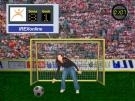
"It's not exactly normal," admits Weiss to ISRAEL21c, laughing at the contrast between her traditional way of life and the 'Brave New World' that characterizes her professional pursuits.
But Weiss sees no contradiction between the two. "I have always been interested in different technologies and my goal has always been to help people," says the researcher, whose library has volumes of Psalms and kinesiology textbooks side by side.
An occupational therapist by training, Weiss grew up in Canada and taught at McGill University in Montreal for many years, before immigrating to Israel in 1991 with her Israel-born husband. For the last four years she has been a researcher and lecturer at the University of Haifa, and a member of its newly-established Laboratory for Innovations in Rehabilitation Technology.
Weiss's interest in VR was piqued when she read an article by one of the pioneers in the field, Prof. Albert 'Skip' Rizzo of the University of Southern California, nearly a decade ago. That ultimately led to a close collaboration with Rizzo, who also attended this month's symposium.
What interests her about the field? "Look at this," says Weiss, showing a videotape of a woman with a spinal cord injury doing traditional physiotherapy. The therapist hands her a plastic ring which she must grasp without losing her balance - then another ring, and another, and another. "Let's face it. It's very static and very boring."
Now she shows a videotape of another patient who is also learning to balance himself - only he is watching himself on a giant screen, against a breath-taking mountain backdrop, swatting at balls in the sky. Every ball he hits turns into a colourful bird. The scene is virtual, but the man's movements - he is leaping and swatting with increasing determination - are very real.
"It's interesting and motivating," explains Weiss. "I have yet to meet a patient - of any age - who didn't like it. So it's very effective." (In a newer version, she notes excitedly, patients will wear a glove which vibrates whenever they make contact with a virtual ball - further increasing the sense of realness.)
The symposium Weiss organized, which brought leading VR experts from the US, Canada, Europe, Japan and Israel, to Haifa showed the dizzying range of new VR technologies dedicated to health and rehabilitation - from a robotic dog, who can be a reliable companion for the elderly - "no need to feed him or take him for walks," noted the researcher who demonstrated the small, black, yelping Sony invention - to 3D interactive games that could some day be used for early diagnoses of Alzheimer's disease, treatment of attention deficit disorder, and rehabilitation of patients who have suffered central nervous system injuries.
"Virtual reality has completely revolutionized the field of occupational therapy," says Weiss, who is personally involved in several innovative VR projects, including the simulated bus bombing program designed to treat Israelis suffering from severe post-traumatic stress.
That program - developed together with Dr. Naomi Josman, Prof.Eli Somer and Ayelet Reisberg, all of the University of Haifa, as well as with American researchers - is designed to expose patients in a controlled manner to the traumatic incident which they are often unable to remember, but which has a powerful and debilitating effect on their lives.
The realistic rendering of the bus bombing triggers the patient's memories - the first vital step on the path to overcoming trauma. (The simulation does not include all the gruesome details of the attack, but rather just enough to help the patient recall what happened.)
It was Josman who first came up with the idea of using such a treatment in Israel. She was attending a conference in the United States when she saw how University of Washington Prof. Hunter Hoffman had applied VR to successfully treat Americans suffering from PTSD following the 9/11 attack on the Twin Towers.
Similar programs have also been used recently to help American veterans traumatized by their tour of duty in Iraq, and even Vietnam veterans for whom no other treatment has proven effective.
Through close collaboration with Hoffman, the U. of Haifa team developed an Israeli version of the program which is now being used to treat the first few patients.
"If our pilot study is effective, we will launch a full-scale clinical trial," says Weiss, "and hopefully we will be able to provide a solution for those PTSD patients who have been resistant to more traditional cognitive therapy."
In another application of VR technology, Weiss and U. of Haifa colleagues have developed a program to help stroke victims relearn the basic skills required to shop on their own. The patient composes a grocery list and makes his or her way through a 'virtual supermarket,' seeking the right products, pulling them off the shelves and into a shopping cart, while announcements of sales are broadcast on the loudspeaker system.
"It's the first such program designed to improve both cognitive and motor skills of stroke victims," she notes.
Last week, the American Occupational Therapy Foundation (AOTF) invited Weiss to join its Academy of Research, the highest scholarly honor that the AOTF confers.
"Your work clearly helps to move the profession ahead, and demonstrates powerful evidence of the importance of assistive technology in helping persons with disabilities participate in the occupations of their choice, while improving the quality of their lives," the AOTF wrote in its letter to Weiss.
For Weiss, virtual reality is not only the focus of research, but a way of life - at least in her work. She communicates with her colleagues around the world by tele-conference and, of course, email - and notes that she has never even met her close collaborator Hoffman even though they have been
communicating several times a week for years. She also taught an entire university course last semester - without ever attending a lecture hall. Instead, she sat in the comfort of her B'nai Brak home, wearing a headset and microphone to deliver a weekly videoconferenced lesson on assistance technology to students who sat in their own homes.
"They could see a video of me, and whenever a student wanted to speak I would see the icon of a hand being raised. We even had guest lecturers from abroad. The students really appreciated not having to come to the university late at night for the course," says Weiss, who was pleased to be able to - once again - harness technology to help make people's lives a little easier.
10:30 Posted in Cybertherapy | Permalink | Comments (0) | Tags: Positive Technology, virtual reality, cybertherapy
Mar 22, 2005
Virtual reality games alleviate pain in children
From BioMed Central
Immersion in a virtual world of monsters and aliens helps children feel less pain during the treatment of severe injuries such as burns, according to a preliminary study by Karen Grimmer and colleagues from the Women's and Children's Hospital in Adelaide, Australia.
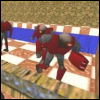
A virtual reality game is a computer game especially designed to completely immerse the user in a simulated environment. Unlike other computer games, the game is played wearing a special headset with two small computer screens and a special sensor, which allows the player to interact with the game and feel a part of its almost dreamlike world. "Owing to its ability to allow the user to immerse and interact with the artificial environment that he/she can visualize, the game-playing experience is engrossing", explain the authors.
Children with severe burns suffer great pain and emotional trauma, especially during the cleaning and dressing of their wounds. They are usually given strong painkiller drugs, muscle relaxants or sedatives, but these are often not enough to completely alleviate pain and anxiety. These medications also have side effects such as drowsiness, nausea or lack of energy.
Grimmer and colleagues asked seven children, aged five to eighteen, to play a virtual reality game while their dressing was being changed. The children were also given the usual amount of painkillers. The researchers assessed the pain the children felt when they were playing and then compared it to the amount of pain felt when painkillers were used alone.
To measure the intensity of the pain, the team used the Faces Scale, which attributes a score from 0 to 10, wherein 10 represents maximum pain, to a facial manifestation of pain. For younger children they used 5 different faces representing no pain to very bad pain. The researchers also interviewed the nurses and parents present during the dressing change.
The average pain score when the children received painkillers alone was 4.1/10. It decreased to 1.3/10 when the children had played a game and been given painkillers. Because the sample size was so small the researchers analysed their results per child, and they found that all but one child lost at least 2 points on the scale when they were playing the game. The parents and nurses confirmed these results and said that the children clearly showed less signs of pain when they played the game.
"We found that virtual reality coupled with analgesics was significantly more effective in reducing pain responses in children than analgesic only" conclude the authors.
This is only a preliminary study, but the researchers are hopeful. They propose to test virtual reality on more subjects, possibly with games appropriate to each age group, in the hope that it could one day greatly reduce, if not completely replace, the use of painkillers.
This press release is based on the article:
The efficacy of playing a virtual reality game in modulating pain for children with acute burn injuries: A single blinded randomized controlled trial Debashish Das, Karen Grimmer, Tony Sparnon, Sarah McRae, Bruce Thomas BMC Pediatrics 2005 4:27 (3 March 2005)
19:30 Posted in Cybertherapy | Permalink | Comments (0) | Tags: virtual reality, cybertherapy
Jan 28, 2005
VR to treat PTSD
From Wired
With a push of a button, special effects will appear -- a mosque's call to prayer, a sandstorm, the sounds of bullets or bombs. "We can put a person in a VR headset and have them walk down the streets of Baghdad," Rizzo said. "They can ride in a Humvee, fly in a helicopter over a battle scene or drive on a desert road."
This is no video game, nor is it a training device. Rizzo and colleagues are developing a psychological tool to treat post-traumatic stress disorder, or PTSD, by bringing soldiers back to the scenes that still haunt them. A similar simulation is in the works for victims of the World Trade Center attacks.
PTSD treatment, the newest frontier in the intersection between virtual reality and mental health, is one of the hot topics this week at the 13th annual Medicine Meets Virtual Reality conference, which began Wednesday in Long Beach, California. Rizzo and others will explore plans to expand virtual reality's role in mental health by adding more elements like touch and the ability to interact with simulations. "The driving vision is a holodeck," Rizzo said. "If you look at the holodeck, and all the things people do in Star Trek, that's what we'd like to be able to do."
Powerful computers are cheaper -- the necessary machines used to cost as much as $175,000 but now the Virtual Reality Medical Center in San Diego, one of about 10 private VR mental-health clinics in the United States, picks up its hardware at Fry's Electronics. VR helmets -- which allow users to turn their heads and see things above, below and behind them in the 360-degree virtual world -- cost as little as a few thousand dollars. And perhaps most importantly, the graphics are more advanced, thanks to partnerships with video-game developers.
At the San Diego clinic, graphics designers are developing a remarkably realistic virtual world based on digital photos and audio from San Diego International Airport. Patients afraid of flying will be able to take a virtual tour of the airport, from the drop-off area through the ticket counter, metal detectors and waiting areas. The simulation is so precise that users can enter restrooms, peruse magazines at the newsstand or wander around the food court; recordings will allow the virtual PA system to offer the requisite incomprehensible announcements.
The clinic already offers a simulation of a flight. At $120 a session, patients sit in actual airplane seats and watch a simulation of a takeoff, accurate all the way down to announcements by flight attendants and pilots. At takeoff, actual airplane audio -- engines revving, landing gear retracting -- is channeled into subwoofers below the seat, providing a dead-on simulation of what a passenger feels. Even the view outside the window is based on actual digital video from a flight.
"Exposure therapy" has long been a common treatment for phobias. "It's a gradual reversal of avoidance," said psychologist Hunter Hoffman, a researcher who studies VR at the University of Washington. "You start by having them hold their ground. A lot of phobics have mental misunderstandings about what would happen if they face the thing they're afraid of. A spider phobic, they may think they're going to have a heart attack -- they think if they don't leave the room, they'll go insane. They have these unrealistic theories about what will happen."
17:25 Posted in Cybertherapy | Permalink | Comments (0) | Tags: Positive Technology, virtual reality, cybertherapy
Jan 05, 2005
Computer generated brain surgery to help trainees
FROM THE PRESENCE-L LISTSERV:
[From E-Health Insider (<http://www.e-health-insider.com/news/item.cfm?ID=988>)...
Researchers at the University of Nottingham have developed a
virtual reality brain surgery simulator for trainee surgeons that
combines haptics with three-dimensional graphics to give what
they claim is the most realistic model in the world.
A 'map' of the brain surface is produced by the software, which
also renders the tweezers or other surgical implement and shows
any incisions made into the virtual brain. The simulator is
controlled by a device held by the user, which uses a robotic
mechanism to give the same pressure and resistance as it would
if it were touching a real brain.
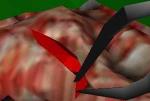
Map of brain on virtual surgery simulator
Dr Michael Vloeberghs, senior lecturer in paediatric neurosurgery
at the University's School of Human Development, who led the
development team, said that the new system would benefit
trainees: "Traditionally a large amount of the training that
surgeons get is by observing and performing operations under
supervision. However, pressures on resources, staff shortages
and new EU directives on working hours mean that this teaching
time is getting less and less.
"This simulator will allow surgeons to become familiar with
instruments and practice brain surgery techniques with
absolutely no risk to the patient whatsoever."
The pilot software was developed with the Queen's Medical
Centre, in Nottingham, which contains a Simulation Centre in
which dummies are often used for surgical training.
Dr Vloeberghs says that the haptic system is an improvement on
the existing system: "Dummies can only go so far – you're still
limited by the physical precense, and you can't do major surgery
on dummies... you can simulate electrically and phonetically what
is happening, but nothing more than that."
Adib Becker, Professor of Mechanical Engineering at the
university, said that the technology could be developed for the
future, and that brain surgery online could even be possible: "If
you project maybe four or five years from now, it may be possible
for a surgeon to operate on a patient totally remotely.
"So the surgeons would be located somewhere else in the world
and can communicate through the internet, and can actually feel
the operation as they are seeing it on the screen."
The team hopes that the piloted software, which was funded by a
grant of £300,000 from the Engineering and Physical Sciences
Research Council (EPSRC), will help train surgeons to a higher
level before their first operation on live patients, thereby
increasing safety.
15:05 Posted in Cybertherapy | Permalink | Comments (0) | Tags: Positive Technology, virtual reality, cybertherapy
Jan 03, 2005
Free ISSUE of Journal of NeuroEngineering and Rehabilitation
Free Papers about VR available from the Journal of Neuroengineering and Rehabilitation
Patrick J. Sparto, Susan L. Whitney, Larry F. Hodges, Joseph M. Furman, Mark S. Redfern
Journal of NeuroEngineering and Rehabilitation 2004, 1:14 (23 December 2004)
[Abstract] [Provisional PDF]
Research
Considerations for the future development of virtual technology as a rehabilitation tool
Robert V. Kenyon, Jason Leigh, Emily A. Keshner
Journal of NeuroEngineering and Rehabilitation 2004, 1:13 (23 December 2004)
[Abstract] [Provisional PDF]
Review
Video capture virtual reality as a flexible and effective rehabilitation tool
Patrice L. Weiss, Debbie Rand, Noomi Katz, Rachel Kizony
Journal of NeuroEngineering and Rehabilitation 2004, 1:12 (20 December 2004)
[Abstract] [Provisional PDF]
Research
Reaching in reality and virtual reality: a comparison of movement kinematics in healthy subjects and in adults with hemiparesis
Antonin Viau, Anatol G. Feldman, Bradford J. McFadyen, Mindy F. Levin
Journal of NeuroEngineering and Rehabilitation 2004, 1:11 (14 December 2004)
[Abstract] [Provisional PDF]
Review
Motor rehabilitation using virtual reality
Heidi Sveistrup
Journal of NeuroEngineering and Rehabilitation 2004, 1:10 (10 December 2004)
[Abstract] [Provisional PDF]
Review
Presence and rehabilitation: toward second-generation virtual reality applications in neuropsychology
Giuseppe Riva, Fabrizia Mantovani, Andrea Gaggioli
Journal of NeuroEngineering and Rehabilitation 2004, 1:9 (8 December 2004)
[Abstract] [Provisional PDF]
Editorial
Virtual reality and physical rehabilitation: a new toy or a new research and rehabilitation tool?
Emily A Keshner
Journal of NeuroEngineering and Rehabilitation 2004, 1:8 (3 December 2004)
[Abstract] [Provisional PDF]
16:45 Posted in Cybertherapy | Permalink | Comments (0) | Tags: Positive Technology, virtual reality, cybertherapy
Dec 09, 2004
Neurotiv project
- Pervasive diffusion of intelligence in the space around us, through the development of network technologies towards the objective of the so-called “Ambient Intelligence” (AmI);
- Increasingly relevant role of mobility, through the develpoment of mobile communications, from the UMTS towards the so-called “Fourth Generation” (4G);
- Increase of reachness and completeness of communications, through the development of multimedia technologies, towards the “Immersive Virtual Telepresence” (TIV), including an increased attention to the aspects of human perception and of person-machine interaction.
The TIV perspective is reached through the complete development of multimedia technologies, generating far away the sense of presence through the integrated availability of sound, vision, smell, touch-and-feel (haptics) signals. Typically, the sense of presence is accomplished through multisensor stimuli by means of which actual reality is either hidden and substituted with a virtual reality, i.e. fully synthetic, or is virtualized, i.e. made virtual through audio and 3-D video analysis and modeling procedures.
The convergence of AmI, 4G and TIV technologies manifests itself as the next frontier of ICT. This convergence will determine the advent of ubiquitous 3-D telecommunications and the built-up of intelligent environments for health care in which complex multimedia contents integrate and enrich the real space. The most ambitious objective is to integrate the computer interfaces in the real environment (Mixed Reality) so that the user can take advantage of the clinical care in the most natural and intuitive way.
The Neurotiv Project aims at improving the know-how level, at generating new development and application opportunities, at organizing and finalizing multidisciplinary skills, and at developing system and component prototypes for the use of TIV technologies in a managed care system for neuropsychology and clinical psychology.
More in detail, the project aims at:
- proving the technical and clinical viability of integrating TIV systems in a managed care platform for neuro-psychology assessment and rehabilitation
- designing/tuning and developing managed care tools to be used in the prevention, planning provision and follow-up of the required treatment. The developed modules will be optimised to meet the demands of the emerging 2,5G/GPRS and 3G/UMTS wireless networks and terminals.
- Defining new treatment protocols for the use of the clinical tools in assessment, therapy and follow up.
- Verify the clinical economic/organizative efficacy of the managed care system by using controlled clinical trials.
- Disseminating the obtained results through scientific papers and conference presentations.
More to explore
The NEUROTIV project web site
19:50 Posted in Cybertherapy | Permalink | Comments (0) | Tags: Positive Technology, virtual reality, cybertherapy
EMMA project

This research will help to understand better the development of some psychopathological phenomena and the development of "new correcting experiences and learnings" to cope those psychopathological experiences.
Furthermore, EMMA project will pretend the development of innovative tools to be used with three different real users:
* users of (real world) mental health services, such as treatment for anxiety disorders, depression, and so on
* users with acute restricted mobility (e.g. designed experiences for hospital inpatients), and
* mood enhancement for general population (relaxation environments through TV or VR).
19:30 Posted in Cybertherapy | Permalink | Comments (0) | Tags: Positive Technology, virtual reality, cybertherapy







